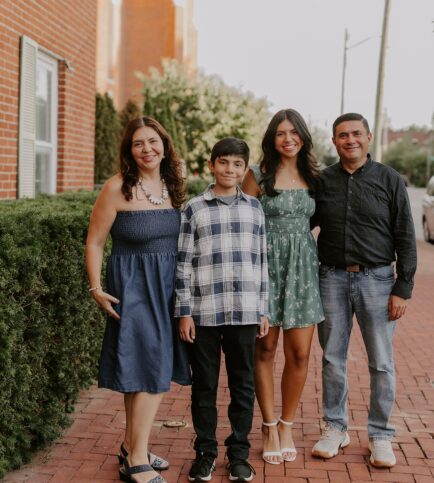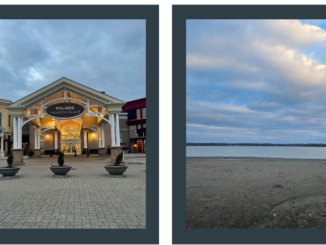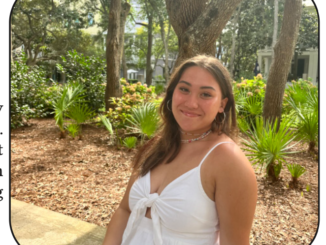
photo credit: Luna Perez Delgado
“It will be scary at first, but you’ll love it eventually,” my mom said. This was her attempt to comfort 7-year-old me in December of 2013 about leaving my family, friends and culture from my home country of Colombia. It wasn’t just me who was scared to leave everything we ever knew.
“I’m scared too sweetie. We all are,” my dad said. I found some comfort in knowing I wasn’t alone in my worry.
When my family and I first moved to the United States, we were all terrified. Trading familiarity and comfort for foreignness and confusion was not an easy feat. Nonetheless, moving to the United States was not an opportunity that could be rejected for most Colombian families, including mine.
“We are so fortunate to be in this country. You have to take advantage of every opportunity available for you,” my mom said.
At first, the resources available to my family were very limited. My mom had an H1B temporary work Visa, while my brother, dad and I were her “dependents.”
This situation meant that because my mom’s work was the reason we moved to America, she was the only person legally authorized to work in the United States. A visa status also indicated that our residency status in the United States could change at any moment; in other words, we never knew for certain if we could continue living in the United States for the rest of our lives.
This pill was always hard to swallow for my family. For six years, we lived with limited freedoms in a country with uncertainty about which country would be our permanent home.
After six long years of waiting and a-soon-to-expire visa, my mom’s work finally decided to sponsor our citizenship process. “We will finally be able to have most of the same rights as most of the people in this country,” my mom celebrated.
The first step to becoming a citizen was getting a permanent residency, and with our residency, came work permits as well. For my family, the main benefit of being sponsored by a company was an expedited process. However, we still had to hire expensive lawyers and pay hefty application fees to be considered for a residency.
After a few months of waiting, my parents were fortunate enough to receive an interview for their residency. A US Citizenship and Immigration Services officer asked them basic questions about our journey to the United States, and at the end, he congratulated us.
“You will receive your work permits, social security numbers and permanent residency card in the mail within two weeks,” the officer said as he shook my parents’ hands.
This was in March 2019, and since then, I have been able to work, apply for financial aid for college and my parents have received from tax benefits, thanks to our residency status.
However, our journey to citizenship was not over. Five mandatory years of waiting later, my parents are once again paying application fees to apply for citizenship.
“You have to help us study for our citizenship test so we can change our status as soon as possible and not have to pay again,” my dad said to my brother and me.
My parents applied for citizenship in October. Since then, my brother and I have been helping them study civics questions for their interviews in January.
We now patiently await their test dates and hope for them to pass their 10 questions on the exam so we can celebrate our citizenship status at their induction ceremony.
“We’ve been working extremely hard for this as a family for more than 10 long years, so we can finally have the same rights as everyone else in America,” my dad said.
This is just part of one of the many stories from an immigrant living in America.
There are many United States immigrants enrolled at the school. One being, Senior Ahmed Karrar grew up in Sudan and moved to the United States in 2018.
“My family moved to the United States for access to good education and at Orange that’s come true. Also before moving, I expected to meet a lot of new people and connect with a lot of people, which was also true,” Karrar said.
A common limiting factor for immigrating to the United States is learning the English language, however that wasn’t the case for Karrar.
“In Sudan, I went to a private school that taught me English and Arabic at the same time so that was really helpful making the educational transition a lot easier,” Karrar said.
However, not every newcomer in the United States has the opportunity to learn English before moving to the country. That’s why Orange takes pride in it’s English Language program that has been steadily growing and currently has 98 students. The head of this program is Dr. Suzie Kim.
“As new EL students arrive at OOHS, we engage our bilingual students to assist with their integration into the school community. When selecting a current student to help, we aim to match them with a newcomer who speaks the same language, is around the same age, and shares a similar gender to respect cultural norms,” Kim said.
Karrar has worked hard to assimilate himself into American culture as well as the culture of the student body at the school. He’s involved in tennis, WISE, face to face club, model UN, and more.
“One of my favorite opportunities at the school outside of the great curriculum is getting to share the values I’ve gained from my culture during the multi cultural fair,” Karrar said.
Despite the opportunities moving to the United States has given to Karrar, there have still been drawbacks to his immigration.
“The hardest part about immigrating to the United States has been leaving my close friends, family and traditions behind in Sudan. However, I combat this struggle through visiting Sudan over the summer and also talking with family through online social media platforms like WhatsApp and Instagram,” Karrar said.
In the future, Karrar aspires to use a combination of his education and cultural experiences to provide opportunities for people in other countries.
“Personally, I see myself pursuing AI and computer science to make an impact in the educational and health systems through using technology in developing countries,” Karrar said.
Senior Pearl Vyas was born in Dubai, then lived in India, and now has lived in the United States since 2016.
“The most rewarding part of my journey to the US was finally living with my entire family again and meeting some of my best friends for life,” Vyas said.
While Vyas has been rewarded from her immigration she has also experienced trials after moving to a different country.
“My expectations were perhaps skewed as I imagined my experience here would start off good. My actual experience adjusting to school here was difficult. I struggled with the change I experienced as a new kid however, it took me time to get where I am today and I’ve grown a lot since moving to the United States,” Vyas said.
Vyas didn’t move past this experience on her own, instead she formed support around herself in the United States.
“Support systems that helped me overcome these growing pains were having supportive teachers and friends whom I could always rely on and that could help me in navigating my education and life in the United States,” Vyas said.
Vyas continues to harp on the importance of surrounding yourself with good people while going through the immigration process.
“My advice to someone who is moving to the US would be that you’re not alone. There are many others around you who feel the same way and are looking for someone to share their experiences with, and that if you find yourself struggling to remember that, those moments/years don’t define your future or who you are as a person,” Vyas said.
Among immigrant communities, healthcare is an ever pressing issue, being continually inaccessible for some immigrants, depending on the circumstances of their immigration, according to Alyssa Huddleston. Huddleston is the Healthcare Executive Director at Lutheran Social Services in Columbus, Ohio, which is a local community health center that often provides services for immigrants.
One of the biggest challenges that Huddleston has noticed regarding Immigrant healthcare, is the language barrier. Sharie McNeil, the Refugee Clinical Care Coordinator at PrimaryOne Health similarly expressed this notion.
“The biggest challenge I have personally experienced working with refugees is the ability for them to express their healthcare needs. Lack of healthcare knowledge, lack of knowledge, cultural differences and language barriers all play a role in accessing quality healthcare,” McNeil said.
Lutheran Social Services does have great interpreter services, but they come with a heavy monthly cost. They also have a limited number of languages available for their patient messaging system. Some patients also struggle with being uninsured and there is a struggle to link them with outside referral sources.
“The main obstacles that are reported to our office are language barriers and transportation. Language barriers can affect their ability to apply for insurance, make medical appointments and understanding their health providers. Transportation to medical appointments is also challenging. Our populations won’t immediately be able to get a driver’s license and will not have a vehicle, so they are reliant on public transportation and others in the community to assist them,” Sandra Holligsworth said.
Hollingsworth is a refugee health coordinator at The Ohio Department of Job and Family Services. They work with specific immigrant populations that come to Ohio, such as refugees, asylees, Cuban and Haitian Entrants, Ukrainian Humanitarian Parolees who arrived prior to October this year and Afghan Humanitarian Parolees who arrived prior to October last year. Hollingsworth’s Office mainly works with refugees.
Specifically for refugees, there are a few requirements that they have to meet to be allowed to travel to the United States. They can’t have any communicable diseases that are infectious at the time of their travel, and if they do, it must be treated before they can enter the country.
Refugees also receive and oversee medical exams prior to traveling to the country. The exam is provided to them by the International Organization for Migration which is part of the United Nations, and this organization also provides them vaccinations, according to Hollingsworth.
“The populations we work with also have health requirements for them to adjust to lawful permanent residents. This usually takes place around one year after their arrival to the U.S. To adjust to permanent residency, they must submit a form called I-693 Report of Immigration Medical Examination and Vaccination Record with their application for permanent residency to USCIS. This form must be completed by a civil surgeon,” Hollingsworth said.
Similarly, McNeil acknowledges that HIV is one of their most seen conditions in immigrants, along with a variety of mental health issues, which tend to be overlooked when addressing health conditions.
“Some of our immigrant/refugee populations are more at risk for communicable diseases like, hepatitis C, tuberculosis, HIV/AIDS due to environmental conditions in their home country. We may also see an increased risk for diabetes and cardiovascular disease due to lack of access to healthy and nutritious food options,” Huddleston said.
However, according to Hollingsworth, refugees in Ohio who have chronic illnesses and disabilities get special consideration prior to resettlement. Agencies that are going to assist them are informed on their condition and develop a plan for how to best assist them when they arrive in the United States.
While there are some challenges for immigrants trying to access healthcare, Ohio has some great refugee programs. There have also been many steps forward, especially the Affordable Care Act, which expanded Medicaid options for immigrants with citizenship. Some select refugees also have access to resettlement agencies who can help guide and assist in seeking healthcare, employment and housing.
“Refugees/immigrants in the state of Ohio are receiving a tad bit more attention considering so many seek refuge in our state. The Ohio Refugee Services Program is part of Ohio’s Department of Job and Family Services (ODJFS) and serves as the refugee resettlement office. The program includes cash and medical assistance, access to English language classes, vocational and employment assistance,” McNeil said.
Immigrants do face challenges when trying to access healthcare, like language barriers, no insurance and lack of knowledge about healthcare. Those who seek to relocate to the United States also have to go through screening. However, government agencies and nonprofits are making many steps forward in Ohio and overall, as a country. Medicaid has been extended, most FQ healthcare organizations have a ‘no patient turned away’ policy that allows under insured or no insurance patients to be seen and billed based on their income, and Ohio overall offers a lot of assistance. Overall, Ohio has many resources available to their immigrant populations.
On a broader perspective, immigration has divided this country for as long as most Americans can remember. From threats of building walls to mass deportations, it is arguably the most polarizing issue of our time. According to PEW Research Center, about 61 percent of registered voters said that immigration was a very important issue during the 2024 election.
It is well known that the issue provokes heated debate from both sides, but what is the exact impact of partisanship on this issue? For an issue that troubles Americans across the board despite party affiliation, both sides have different views. It is time to get to the bottom of the immigration deadlock.
“Both parties need to move toward the middle and find common ground,” junior Ben Whitehead said.
First, it should be acknowledged that the vast majority of voters are moderate, and favor both of these two ideas. Almost everyone believes that the United States of America should not have a completely unregulated border. The Department of Homeland security acknowledges that many migrants face the threat of “smugglers, criminals, cartels, and bad actors prey on vulnerable migrants, who risk kidnapping, extortion and other threats to their personal safety.”
In addition to the pain and suffering endured by those who travel across the border, an open border also has negative implications for the United States. Despite major differences in policy positions, both Kamala Harris and Donald Trump were clear that the immigration system was broken and lamented the surplus of fentanyl and other illegal drugs entering the United States.
It is clear that the current immigration system is not working. Both sides of the aisle agree on this. Republicans blame the Biden-Harris administration for enabling the unprecedented amount of illegal immigration while Trump’s actions are heavily awaited.
“It’s being reported that the federal government is trying to secure facilities to temporarily store people,” AP US Government teacher John Carmichael said. “They are then going to be taken out of the country.”
Carmichael noted the scale of Trump’s mass deportation plan.
“Some are saying people will be deported in the tens of thousands. Some say in the hundreds of thousands. It’s going to be absolutely different than anything we’ve ever seen,” Carmichael said.
It is agreed upon by both parties that the immigration system is broken. For moderates, it is also agreed upon that the United States should not neglect the plight of migrants seeking to enter the country. Many are familiar with the disturbing details of how migrants were treated during the first Trump term. A majority of voters—Democratic and Republican—agree that the border must be reformed, while also maintaining a humane approach to handling the migrants.
“The consensus on the immigration issue from Democrats and Republicans over the past 30 years is that it’s broken,” Carmichael said. “They disagree on how to fix it.”
With President-elect Trump’s second term coming up, the partisanship divides on the issue are set to be as prominent as ever. A Trump presidency and an additional Republican control of the House and Senate means that MAGA’s policies are likely to be enacted. Overall, the current political situation is influenced heavily by partisan loyalties.
“The role political parties play is fundamental to the new policy you’re going to have,” Carmichael said.
In fact, after Kamala Harris’s defeat in the election, some predict that Democrats will move to the right on immigration. NPR writes that due to push back from voters, the Biden administration enacted several policies that mimicked the Trump agenda. It seems that the majority of American voters believe that the immigration system needs reform.
“Politicians from both sides must do the right thing and meet in the middle,” Whitehead said. “It’s our nation’s best chance.”
Despite the party, America is inching closer to a lasting border solution that will be the common stance of politicians from now on. Immigrated populations make up a large portion of the county’s population, and have stories which are a vital part of the American narrative.


